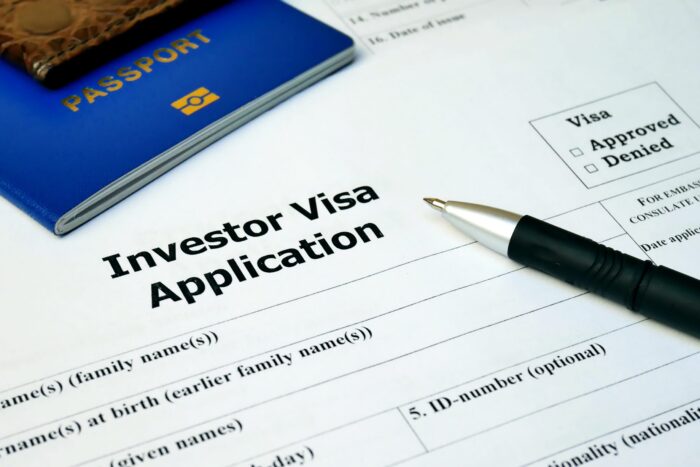
The most well-known type of visa is the K-1 visa, but there are many, many more out there. The different types of visas all serve different types of workers, including people hoping to start businesses. America prides itself on being a land of opportunity, so if you’re an entrepreneur, you may want to consider investor visas. Read on to learn more about this set of immigration documents and how they differ.
What Is an Investor Visa?
The “golden visa,” AKA the EB-5, is a type of investor visa that allows enterprising immigrants and their families a green card. There is no language requirement, and wait times are often shorter than for other types of visas. To many immigrants, the EB-5 looks like an easy way to get into America, giving it the nickname “golden visa.”
But don’t get too hopeful. EB-5 visas require a large amount of investment up-front. Keep reading for a breakdown of the benefits and costs of the EB-5 visa. If you are concerned about any of these, it may be worth asking an investor visa attorney from warrenlawfirm.net before you apply.

Why Choose an Investor Visa?
There are several benefits to choosing an investor visa over other types of visas. The most obvious is that this visa has a high chance of granting permanent residency in the United States; the U.S. has some green cards set aside for investors. Once upon a time, it also sped through the system compared to most other types of visas. As an added incentive, it allows the investor’s immediate family to get green cards as well.
At first glance, this looks like a golden opportunity—an opportunity so good that there has to be a catch, right? The EB-5 has some steep requirements that are worth working towards, but it’s not a free ticket by any stretch.
What Are the Requirements for an Investor Visa?
Different types of investor visas have different requirements, such as significant differences in investment costs. The E-2 and EB-5 investor visas require commitments in thousands, if not millions, of dollars. They also have specific employment requirements.
To apply for an EB-5 investor visa, the applicant must…
- Invest at least $800,000.
- Be investing in an area with low employment or a rural area.
- Be from a country that is on good terms with the United States. Please look for this list online.
- Create 10 permanent, full-time jobs in the United States.
Someone needs a substantial amount of capital before they can consider an EB-5! This visa requires hard work before you apply for it. It is not a golden ticket to America, but it is still a good deal if you can meet those requirements.
The E-2 is a less strict, but also less permanent investor visa. Both the E-1 and E-2 visas are “treaty trade” agreements requiring the applicant to be from a select list of countries on good terms with the United States. The E-2 requires a $100,000 minimum investment in American business. To learn more about the different kinds of investor visas, see the section below.

What Types of Investor Visas Are There?
The most important types of investor visas are the E-2 and EB-5. Both of these visas are for foreign entrepreneurs with employees in the United States. The biggest difference between these two is that E-2 is temporary, and EB-5 is permanent. You also cannot obtain a green card with an E-2 visa.
The E-2 visa is also significantly restricted by nationality. The United States government has a detailed list of which countries can use E-1 and E-2 visas. The EB-5 has no such restriction.
But an E-2 visa might be better if you can’t afford the $800,000 investment of the EB-5. The EB-5 also requires that the employees be in an area with low employment or a rural area. Finally, there are some loopholes in the E-2 that allow employees to get these visas. Ask your visa lawyer which investor visa might be the right one for you.
Here are four different types of investment visas side-by-side to help you make the best decision:
| Type of Visa | Qualifications | Investment | Permanent? |
| E-1 | Must carry on trade with the U.S. and be from a treaty country. | No minimum | No. |
| E-2 | Must be from one of the 32 treaty countries. Can also be an employee. | $100,000 minimum | No, but it can be extended indefinitely. |
| EB-5 | Must directly create full-time positions for American employees and invest in an area in need of employment. | $800,000 minimum | Yes. |
| O-1 | Must have exceptional talent (arts, business, athleticism, etc.). | Filing fee | No; less than 3 years. |
The bulk of this article is concerned with E-2 and EB-5 visas. They are the most common ways for immigrant entrepreneurs to gain residency in the United States; note that the E-2 requires extra steps to gain U.S. citizenship. If you think you might want an E-1 or O-1 visa instead, ask an investor visa attorney to help find the best fit for your business.
Do I Need a Lawyer to Apply for an investor visa?
While it is not necessary to hire an attorney to apply for a visa, investor visa attorneys are trained to look for certain documents. It would be awful to apply for an investor visa, only to get rejected because you missed a piece of paperwork.
An attorney will also tell you if you are eligible for an E-1 or E-2 visa in the first place. Remember that only certain countries are allowed to get E-2 visas. It may seem like a lot but asking an attorney to check your paperwork could save you a lot of time, stress, and money in the long run.

Conclusion
As with any legal document, applying for an investor visa can be confusing. The E-2 and EB-5 in particular have small but significant differences between them. While an investor visa attorney is not strictly necessary, they can help you choose the best option for you and your business. Contact us about our investor visa attorney services today!
















